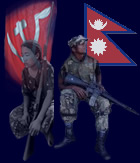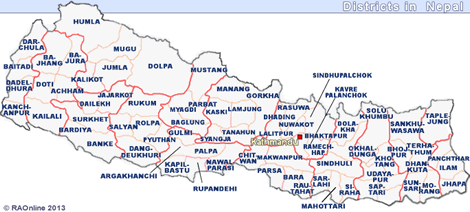| Reports
on Nepal's Civil War |
|
Harsh
lessons of Nepal's insurgency
|
November
2004
| School
principal fears for pupils and society |
In
her home up a steep wooden staircase in Sandhikharka, a district capital
in Nepal's mid-hills, 15-year-old Pratiba Acharya is extremely bored. She
is confined to her tiny bedroom, its walls lined with pop-star posters
and her schoolbooks piled high on her desk. It has been this way since
Maoist rebels ordered the closure of all 17 private schools in the district,
including hers, a month ago, saying private education was unfair. "We'd
heard that Maoists thought that only rich people study in boarding schools
like mine, so they want to close them," says the shy 15-year-old in impeccable
English. But, she adds, many poor people scrimp and save to send their
children to the district's private schools. Pratiba's family cannot afford
to send her away to study, so like many of her classmates she is idle and
deeply worried about her plans to study science.
 |
Full
story ... |
 |
BBC Harsh
lessons of Nepal's insurgency
(November
2004) - no link
|

|
|
Bajura:
We came, we saw, and we fled
|
October
2004
| We
came, we saw, and we fled |
By
the time we reached the powerhouse at Ghat Khola it was already 7PM. It
was getting dark and there was a curfew at eight at our destination: the
Bajura district headquarter at Martadi.
So
we sent colleague Bhojraj Badu ahead to tell officials there we were on
our way. But when he was halfway to Martadi, Bhojraj was accosted by a
bunch of soldiers on patrol.
 |
Full
story ... |
 |
Nepali Times We
came, we saw, and we fled
(October
2004) - no link
|
|
Palpa:
Forced indoctrination
|
September
2004
| Students
in Palpa mistook visiting journalists for Maoists and fled, fearing abduction |
Aside
from closing down most schools, the Maoists have intensified the forced
indoctrination of children in west Nepal as part of a recruitment campaign.
Thousands of students had fled Gulmi after rebels made it mandatory for
one person from each family to join their force so they could make a brigade.
Most fled to Bhairawa, Butwal or to India to find work, giving up their
studies altogether.
 |
Full
story ... |
 |
Nepali Times Forced
indoctrination
(September
2004) - no link
|
|
No
recruitment problem in Bardiya
|
September
2004
| Many
support the Maoists out of fear, but here there is no choice |
Here
on the fertile plains of the Karnali, the maize fields are ripe. The comrades
have guns slung over their shoulders as they help villagers pluck the cobs.
Most young men and women have fled the villages and there aren't enough
people to work the fields.
The
Maoists wipe the sweat from their faces and adjust the straps on their
captured SLRs and INSAS assault rifles. A young female Maoist carries a
303, and expertly breaks the maize from the stalks.
 |
Full
story ... |
 |
Nepali Times No recruitment problem in Bardiya
(September
2004) - no link
|
September
2004
| Closure
of major industries |
Nepal
tourism industry, which was all set for a turnaround this autumn, has been
devastated, first by the international media's coverage of the weeklong
blockade, then by the blasts near Soaltee Crown Plaza and finally by last
week's riots.
The
rebels had selected top companies from each sector - tourism, garment,
carpets, even gas stations and bus companies - for indefinite closure since
17 August. On Friday, 34 other business houses were told to close, or else.
As if to drive home the point, the Maoists exploded three bombs at Malla
Hotel on Tuesday night.
The
rebels say their demands for labour reform have not been met. FNCCI Chairman
Binod Bahadur Shrestha says labour issues can be sorted out, but it is
clear the Maoists are only using the closure to pressurise the government.
 |
Full
story ... |
 |
Nepali Times Hitting
where it hurts
(September
2004) - no link
|
|
Final
US volunteers leave Nepal
|
September
2004
| U.S.
Peace Corps Suspends Program in Nepal |
Press
Release September 13 , 2004
Peace
Corps Director Gaddi H. Vasquez today announced the suspension of the Peace
Corps program in Nepal effective immediately.
"The
Peace Corps has had a successful 42-year program in Nepal, making great
strides in the areas of small business development, education, environment,
youth development and working on health and HIV/AIDS education and awareness.
The safety and security of the volunteer is the number one priority of
the Peace Corps and in light of the current conditions in Nepal, suspension
of the program is a necessary action," said Peace Corps Director Vasquez.
Currently,
Peace Corps volunteers are being consolidated.
The
Peace Corps program in Nepal began in 1962. Since then, more than 4,000
Americans have served as Peace Corps volunteers in the East Asian country. |
BBC:
Marxist
rebels were accused of bombing the US information centre.
The
last volunteers of the US Peace Corps have left Nepal after their organisation
suspended its operations there because of safety concerns. The departure
of the 84 volunteers had become inevitable after the US state department,
which runs the Peace Corps, decided to stop work in Nepal. Peace Corps
volunteers in Nepal have been working in the health, sanitation, teaching,
water and forestry fields.
The
bombing of a US information centre last week triggered the withdrawal.
No-one was injured in the attack, which was blamed on Maoist rebels. The
rebels did not say they were responsible but their anti-American rhetoric
is forthright and they recently demanded that all US companies withdraw
from Nepal.
 |
Full
story ... |
 |
BBC Final
US volunteers leave Nepal
(September
2004) - no link
|

|
|



